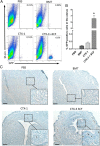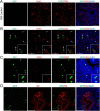A Murine 5-Fluorouracil-Based Submyeloablation Model for the Study of Bone Marrow-Derived Cell Trafficking in Reproduction
- PMID: 27427897
- PMCID: PMC6285241
- DOI: 10.1210/en.2016-1418
A Murine 5-Fluorouracil-Based Submyeloablation Model for the Study of Bone Marrow-Derived Cell Trafficking in Reproduction
Abstract
Bone marrow (BM)-derived cells (BMDCs) contribute to endometrial regeneration. Our objective was to develop a nongonadotoxic mouse BM transplant (BMT) model using 5-fluorouracil (5-FU) for investigating BMDCs trafficking in reproduction. Female C57BL/6J mice received either single (CTX-1) or paired (CTX-2) 5-FU (150 mg/kg) dose, or single (CTX-1+SCF) or paired-dose (CTX-3+SCF) 5-FU with stem cell factor (SCF). Control mice received BMT only or saline. BM cells (20 × 106) from transgenic green-fluorescent protein (GFP) mice were injected iv. For fertility experiment, mice were mated on day 28 after BMT. Alternatively, mice were killed 1 month after BMT and BMDCs recruitment to the uterus was determined. Mice receiving 5-FU ± SCF showed intact ovarian function and fertility. CTX-3+SCF resulted in greatest BM donor chimerism at 1 month (∼45%). Flow cytometry analysis demonstrated that 6.6% of total uterine cells in CTX-3+SCF mice were GFP+ BMDCs. Remarkably, this was about 40- and 80-fold greater than BMDCs in uterus of CTX-1 or BMT only mice (6.6% vs 0.16% vs 0.08%, respectively, P < .001). Immunohistochemical analysis showed that BMDCs in the uterus were mostly localized to the endometrial stroma (71.8%). The majority of endometrial BMDCs colocalized with the pan-leuokocyte CD45 marker (58.5%), but 41.5% were CD45-negative. Cytokeratin and CD31 staining showed that the GFP+CD45- cells were not epithelial or endothelial, confirming their stromal identity. We demonstrate that paired-dose 5-FU regimen results in efficient BM donor chimerism while maintaining ovarian function and fertility. This model could be used for studying BMDCs trafficking to the uterus in various reproductive physiological and pathological conditions.
Figures





Similar articles
-
Bone marrow-derived progenitor cells contribute to remodeling of the postpartum uterus.Stem Cells. 2021 Nov;39(11):1489-1505. doi: 10.1002/stem.3431. Epub 2021 Aug 6. Stem Cells. 2021. PMID: 34224633 Free PMC article.
-
Systemic administration of bone marrow-derived cells leads to better uterine engraftment than use of uterine-derived cells or local injection.J Cell Mol Med. 2018 Jan;22(1):67-76. doi: 10.1111/jcmm.13294. Epub 2017 Aug 7. J Cell Mol Med. 2018. PMID: 28782281 Free PMC article.
-
Contribution of different bone marrow-derived cell types in endometrial regeneration using an irradiated murine model.Fertil Steril. 2015 Jun;103(6):1596-605.e1. doi: 10.1016/j.fertnstert.2015.02.030. Epub 2015 Mar 23. Fertil Steril. 2015. PMID: 25813284
-
Experimental evidence for bone marrow as a source of nonhematopoietic endometrial stromal and epithelial compartment cells in a murine model.Biol Reprod. 2013 Jul 11;89(1):7. doi: 10.1095/biolreprod.113.107987. Print 2013 Jul. Biol Reprod. 2013. PMID: 23699390
-
Bone marrow transplantation generates immature oocytes and rescues long-term fertility in a preclinical mouse model of chemotherapy-induced premature ovarian failure.J Clin Oncol. 2007 Aug 1;25(22):3198-204. doi: 10.1200/JCO.2006.10.3028. J Clin Oncol. 2007. PMID: 17664466
Cited by
-
Current advances in understanding endometrial epithelial cell biology and therapeutic applications for intrauterine adhesion.Stem Cell Res Ther. 2024 Oct 25;15(1):379. doi: 10.1186/s13287-024-03989-6. Stem Cell Res Ther. 2024. PMID: 39456113 Free PMC article. Review.
-
Bone Marrow-Derived Cells Trafficking to the Oviduct: Effect of Ischemia-Reperfusion Injury.Reprod Sci. 2018 Jul;25(7):1037-1044. doi: 10.1177/1933719118770552. Epub 2018 Apr 15. Reprod Sci. 2018. PMID: 29658434 Free PMC article.
-
Examination of the ovotoxicity of 5-fluorouracil in mice.J Assist Reprod Genet. 2018 Jun;35(6):1053-1060. doi: 10.1007/s10815-018-1169-6. Epub 2018 Mar 27. J Assist Reprod Genet. 2018. PMID: 29589294 Free PMC article.
-
CXCR4 or CXCR7 antagonists treat endometriosis by reducing bone marrow cell trafficking.J Cell Mol Med. 2020 Feb;24(4):2464-2474. doi: 10.1111/jcmm.14933. Epub 2020 Jan 6. J Cell Mol Med. 2020. PMID: 31904910 Free PMC article.
-
Bone-marrow-derived endothelial progenitor cells contribute to vasculogenesis of pregnant mouse uterus†.Biol Reprod. 2019 May 1;100(5):1228-1237. doi: 10.1093/biolre/ioy265. Biol Reprod. 2019. PMID: 30601943 Free PMC article.
References
-
- Krause DS, Theise ND, Collector MI, et al. . Multi-organ, multi-lineage engraftment by a single bone marrow-derived stem cell. Cell. 2001;105:369–377. - PubMed
-
- Taylor HS. Endometrial cells derived from donor stem cells in bone marrow transplant recipients. JAMA. 2004;292:81–85. - PubMed
-
- Mints M, Jansson M, Sadeghi B, et al. . Endometrial endothelial cells are derived from donor stem cells in a bone marrow transplant recipient. Hum Reprod. 2008;23:139–143. - PubMed
-
- Ikoma T, Kyo S, Maida Y, et al. . Bone marrow-derived cells from male donors can compose endometrial glands in female transplant recipients. Am J Obstet Gynecol. 2009;201:608, e601–e608. - PubMed
MeSH terms
Substances
Grants and funding
LinkOut - more resources
Full Text Sources
Other Literature Sources
Medical
Molecular Biology Databases
Research Materials
Miscellaneous

